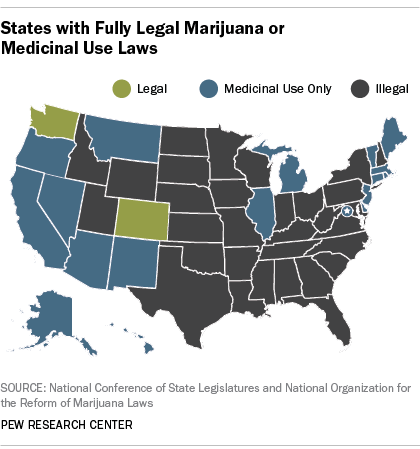November was expected to be a very big month for the pro-marijuana movement and Washington seems to have made an impact on the industry, helping Oregon and Alaska enact new laws that legalized marijuana. Oregon became the third state to introduce recreational marijuana to the economy. Alaska followed shortly after with Measure 2, legalizing possession, sale and use of marijuana in the state. Washington’s legalization of marijuana in 2012 may have paved the way and made it easier for other states to introduce marijuana reform.
Marijuana law reform is sweeping the nation and its legalization in Oregon and Alaska prove that Americans are embracing the change. Marijuana’s benefits to society is evident in states that have already legalized recreational cannabis. With Washington being one of them, Seattle benefits from the millions of dollars in tax revenue that marijuana is projected to make. It’s a booming industry and surely any state that legalizes it is going to increase their tax revenue. For Oregon, Washington, Alaska and Colorado, it’s already being collected. Marijuana’s legalization takes revenue out of the hands of gangs and puts it in the hands of small business owners and entrepreneurs that are relying on marijuana to feed their families. Cannabis is being called the next gold rush, and it’s an opportunity for Americans to get behind something that could significantly boost the nation’s economy. With no indication that legalized recreational marijuana hurts society, increases crime or has much of a downside, it’s no wonder Oregon and Alaska have joined in on this cash cow.
Oregon passed Measure 91 with 54.2%, having needed 50% to pass and Alaska’s Question 2 measure received just 52.1% of the vote. Both states will regulate and tax marijuana at $35 per ounce in Oregon and $50 per ounce in Alaska. It’s expected to bring in millions of dollars in tax revenue for both states.
DC decriminalizes marijuana
Washington DC’s Initiative 71 proposed new law to decriminalize the possession and growth of marijuana. It passed with an overwhelming 69.4% of the vote. Let’s remain hopeful as marijuana supporters that this will draw attention to marijuana’s federal legality and encourage federal law makers to consider nationwide reform. Researchers hope for new classification of the drug, changing it from a Schedule I drug to a Schedule II.
Florida takes a stumble
However, as we’ve seen with marijuana time and time again, with every step forward there’s always some hesitation. Florida’s Amendment 2 proposed legalized medical marijuana for the state and although it receive 57.6% of the vote, it needed 60% because of the states constitutional threshold. While in any other state it would have been a success, Florida will have to re-vote in two years and hopefully then, the state will have a better turnout of young voters. Florida had much of its marijuana support in the younger population of the state and while polls indicated there was enough support for it to go through, young voters may not have turned out like expected.
California – No more felonies for drug possession
California is making new ground on ending prohibition altogether. Proposition 47 de-felonized low-level crime, including possession of all drugs, as long it’s for personal use. If the individual is not selling or distributing it, or have enough of the drug on them to indicate this, police officers won’t be able to charge personal drug users with felonies. This will decrease the number of drug users in prison and provide more room for violent felons. Drug users that have never been charged with a violent crime or drug trafficking will no longer be at risk of serving prison time.
De-felonizing low-level crime and drug possession of all types is a libertarian philosophy promoted by previous republican Ron Paul. It’s a measure that takes personal use and possession charges out of the war on drugs, so that police offers can focus their attention toward drug trafficking and distribution. California passed Proposition 47 with an overwhelming 58.2% of the vote, showing good sign that the measure could spread to Washington, Oregon and other states in the pacific northwest.
